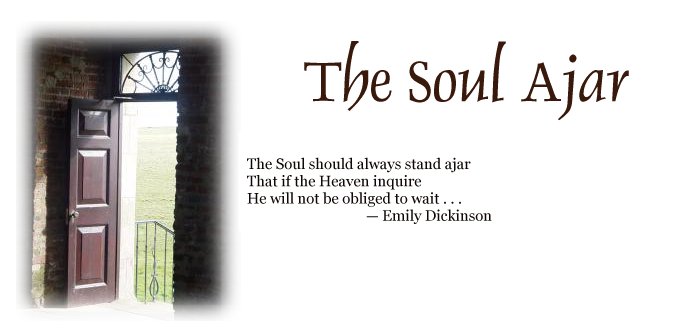Gonna be some changes, some
changes made.
Can't keep on doing what I've been doing these days.
Better figure out something, things are looking grave.
Gonna be some changes, changes, changes made.
— Bruce Hornsby
You can already see some of the changes. There's a new title graphic
which makes use of a picture grabbed from
Stock.xchng,
a wonderful resource for beautiful images free for the taking. The
other immediate change is the alteration of the epigraph.
Originally the line read, "The soul should always stand ajar, ready to
welcome the ecstatic experience." I found it as an "accidental Emily,"
an instance when a reference to Emily Dickinson just pops up in some
nonacademic experience I'm having, such as watching a television show
or reading a popular magazine. This particular line was in a catalog
that landed here unbidden during the holiday shopping season. (I shop a
lot through catalogs and so get hundreds more that I never order from.)
This one was called "
Dwell
in Possibility: Books for the Mind, Art for the Soul." It features
products for promoting personal growth and self-confidence, primarily
in women — elegant bound journals and sketch books, guides to menopause
and nurturing your authentic self. I liked the thought, and it seemed
to fit my hopes for the year, that I would be open to the new and
the unexpected. I thought that the author of the catalog said the line
was from one of Dickinson's letters.
So I began using the line in December, when I resurrected my journal
yet again. But something kept needling at me about the line. It just
didn't
sound like Dickinson.
She didn't make pronouncements about how to live. She made
observations, allowing the reader to find an application in his or her
own life.
So I asked some of my friends on
Circumference,
the discussion list I operate for matters Dickinsonian. We knew that
"The Soul should always stand ajar" was the first line of a poem (#1055
in the Johnson numbering system). but the "ecstatic experience" part
did not follow. Someone has a concordance of the letters and located
the three instances where Dickinson uses the word "ecstatic." The
thought as presented was not found there.
So then I started poking around on Google. Searching on "soul should
always stand ajar" and "ecstatic experience" returned nearly 750 hits.
I paged through them (I have a fast connection and lots of time to
spend avoiding writing fiction), and concluded that the line is bogus.
I have a suspicion (that I have not taken the time yet to confirm) that
it is a mangled reference to something Sarah Ban Breathnach wrote in
her book
Simple Abundance, a
collection of short essays aimed at giving readers permission to feel
good about themselves. Taken out of context by careless writers, the
whole of it became attributed to Emily Dickinson, even though Ban
Breathnach was perhaps only using poem # 1055 as a jumping off place.
What irritated me was finding the line in hundreds of quotation
collections, all giving Emily Dickinson as the author but none giving a
complete citation. It also turns up in sermons or in other "make the
mosyt of life" messages, as the signature line on message boards (where
the author is sometime's given as "Emily Bleepinson," probably in an
effort to defeat smut filters that view the first part of the poet's
surname as suspect. There are also a fair amount of attributions to
"Emily Dickenson," suggesting that the person using the line is less a
devotee of Dickinson than one who grabs an appealing thought presented
by someone else without knowing anything at all about the source.
Last
summer I wrote about correcting a misattribution of my own. The
first time I quoted a song about keeping a grave clean I attributed its
authorship to the folk trio Peter, Paul and Mary, because that was the
information on the record jacket from which I'd first learned the song.
Now I know it's really the work of
Blind Lemon
Jefferson, a legendary blues singer of the 1920s. Getting
quotations and citations correct is part of my makeup as an academic
and a teacher. Further, as one of the keepers of the flame of Emily
Dickinson, about whom there is already so much misinformation, I have
an obligation to get it right.
The actual thought from the authentic poem is less straightforward than
the mutilated and mutated version that now, thanks to the world wide
web, has such wide circulation. Like Dickinson herself, it is
elliptical and says what it needs to between the lines.
I want more changes to come in this site and in myself. Thanks for
still being with me.


